
This post contains affiliate links. For more information, please see my Disclosure Policy.*
Shifty or slippery fabric can be intimidating because it’s so easy to slip off-grain while cutting a pattern. But you can stiffen slippery fabric pretty easily at home!
So how do you make fabric less slippery? What can you put on fabric to make it stiff?
There are a few different ways to do this. Lots of people like to use a high concentration of diluted (or full strength) starch solution. There are also pinning and cutting techniques, such as cutting between layers of tissue paper.
My preferred method to stabilize slippery fabric is to soak it in a gelatin solution. I’ve done this with silks and rayons, from shirting to chiffon, and it always works much better for me than starch or using paper between fabric layers.
I found this method to firm up or stiffen slippery fabric on the Threads website but have since slightly improved on it for my personal use. And then I laid it out in a slightly easier to read format that I thought I’d share with you!
Note, this isn’t the same as stabilizing fabric by using interfacing. This stiffening method is temporary, since the gelatin washes out. Interfacing stiffens the fabric too, but that’s a more permanent application used in collars and facings. You can starch or gelatinize fabric and then apply interfacing to it too. I’ve done this as well—especially in silk shirts. The gelatin will wash out, but the interfacing stays put.
How to Stiffen Slippery Fabric
What you need will depend on how much fabric you need to do at once. This is enough solution for a 3-yard length of fabric. I even used the same solution for 2 different lengths of fabric. So don’t dump it out right away if you have a lot of slippery fabric around.
Tools:
- 1 packet of unflavored gelatin. (I like this brand.)
- 2 quarts water
- Large pitcher that can hold up to 2 quarts or 64 oz (half a gallon) of liquid
- Whisk or long pole to mix water
- Large container/bucket to soak fabric and water mixture
- Clothesline or tension rod
- Your clean fabric (make sure it’s washed beforehand)
The first thing to do is prepare a quart/liter (they’re approximately the same and you don’t have to be exact) of room temperature water and a packet of gelatin. Let that sit for at least 30 minutes but up to an hour.
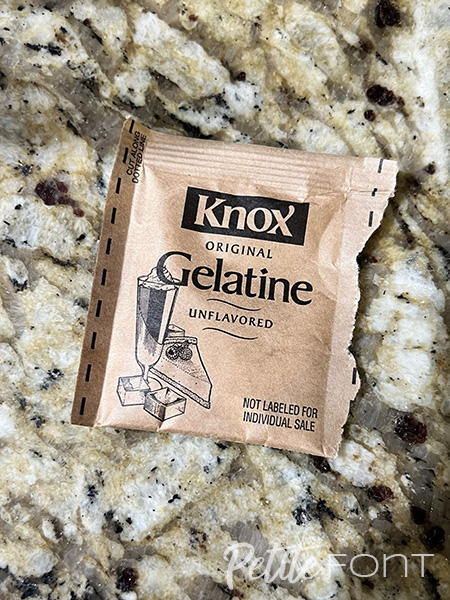

Then bring another quart/liter (or 4 cups) of water to boil.
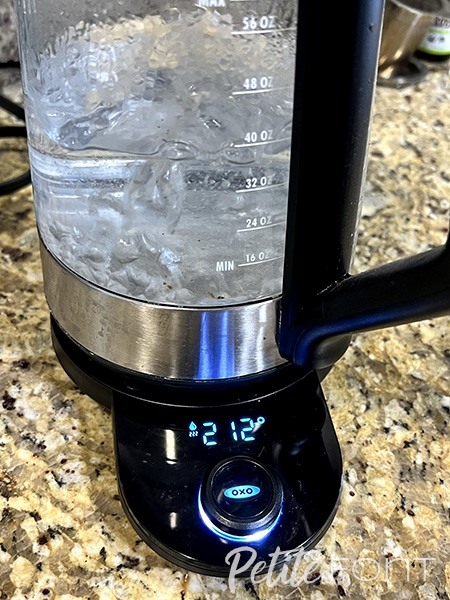
Dump both the boiled water and gelatin mixture into your soaking container. I use a bucket but a shallow tub works too. Mix it up with a whisk or other pole or stick. Be careful—it’s hot!
Add your fabric and let soak for at least one hour. Top off with more water if it’s not completely submerged.
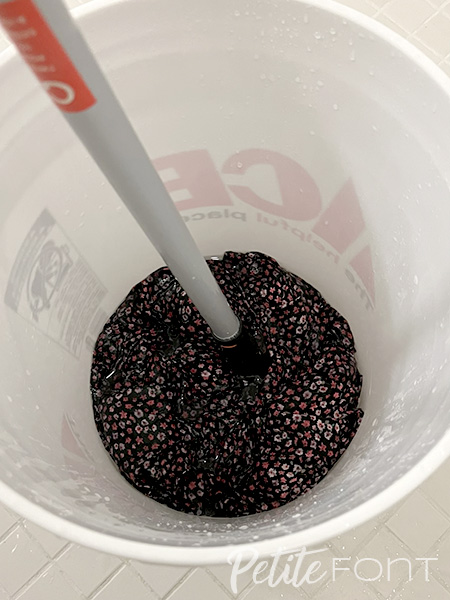
After an hour, wring out the excess water and hang dry. DO NOT RINSE! That will completely defeat the purpose of this entire operation.
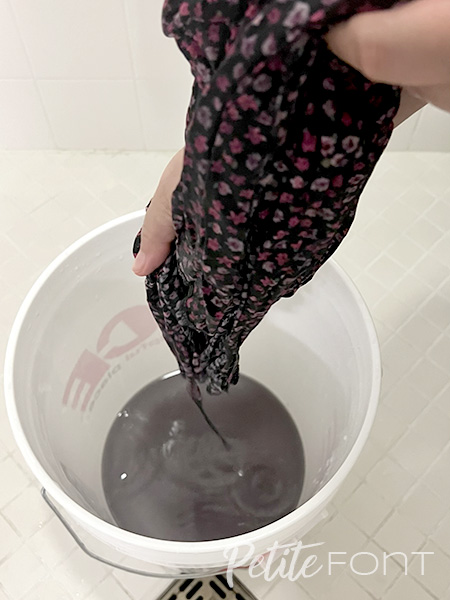
How long your wet fabric will take to dry and become completely stiffened depends on:
- fabric thickness
- fabric length
- relative level of humidity
I hang the fabric in my shower on a tension rod or over the door, but an outdoor clothesline or clothes drying rack works too.
But what if your hanging rack or tension rod isn’t wide enough to hold your entire width of fabric? This always happens to me. My one tension rod is only 4 feet long, and most apparel fabric is closer to 5 feet wide so I have to get creative. But that’s what sewing is all about: creativity! So I do one of three things.
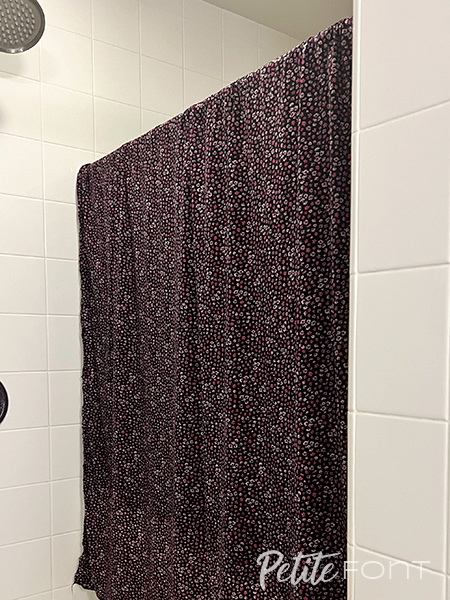
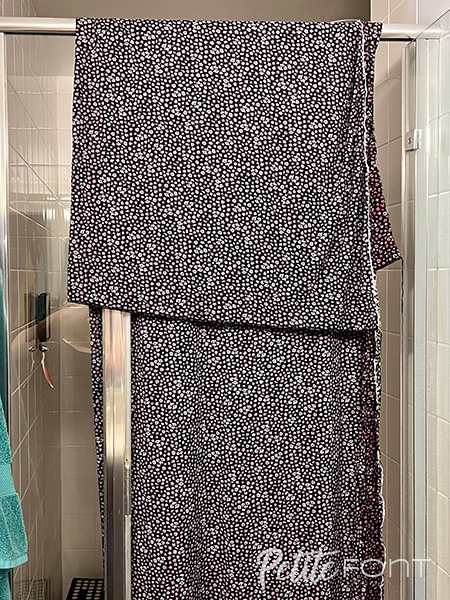

- Spread the wrinkles out equally across the entirety of the fabric so they’re not clumped in one area. Watch your fabric as it dries because these areas will take longer. As other areas dry, you can smooth the wrinkles out so they dry without causing creases.
- Fold the fabric in half, smooth out all wrinkles, and hang it like this. It might take a little longer to dry than if it’s not folded, but it works out fine.
- Alternatively, you can also just fold over the overage and leave the rest flat.
Don’t rush this step! You can’t throw the fabric in the dryer because the heat will melt the gelatin right off, ruining all your work up to this point. But you can point a fan at the fabric to help it along. I’ve had chiffon dry in less than an hour but rayon take 3-4 hours hanging in my bathroom.
Pro-tip:
Do this the day before you plan to cut into your fabric so if nothing else, you can leave your fabric to hang overnight.
Voila! Your fabric will be stiffer.
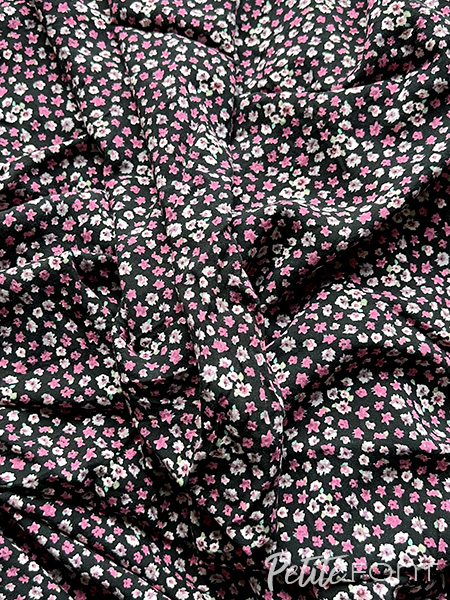
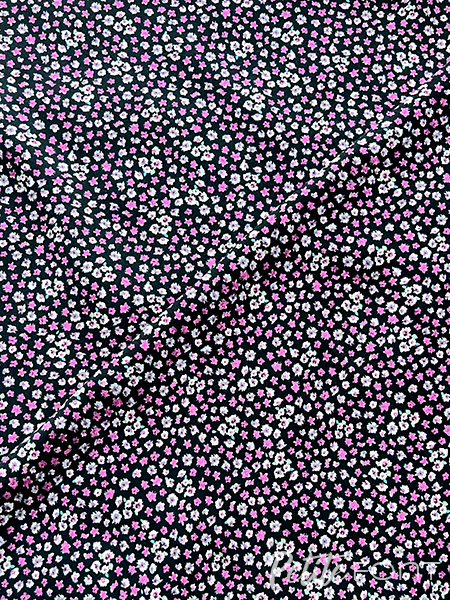
I know it looks like I simply ironed my fabric, but that’s not what happened. The first picture is just before I dunked the fabric in the gelatin solution. The after is straight off the curtain rod the following morning.
A bonus to this process: your wrinkles will disappear too! No need to pre-iron before cutting. Win!
With this gelatin solution, the fabric won’t be as stiff and stable as, say, quilting cotton. You could probably get it that stiff if you really wanted to by experimenting with your own concentration of gelatin solution. But it does take away enough of the slipperiness so it doesn’t shift off-grain.
I have used higher concentrations of gelatin for super slippery fabrics like silk. Instead of 1 packet, I used 2 for those instances. This didn’t turn it into a stiff board either. There’s still a lot of drape to the fabric even with double the gelatin.
FAQs about Stiffening Slippery Fabric
If you have any additional questions, leave them in the comments so I can add them to this FAQ section!
Will my fabric be crunchy or feel slimy after using a gelatin solution?
No, it won’t. The gelatin solution won’t turn into jello either! There’s just enough gelatin in the water to keep the fabric from being as slippery without it becoming stiff as a board.
Can you reuse this gelatin solution?
Yes, but be careful of any fabric dye in the water. As you can see from the photos above, this particular fabric did run. I haven’t had that problem in the past—but there is a possibility that I forgot to wash this fabric before stiffening it. Oops! But I did reuse the solution for another black floral rayon and it was fine. No dye transfer to worry about (this time).
Where do you dispose of your gelatin solution?
Whatever you do, don’t dump it down the drain! If a little goes drains down from your hanging fabric, it shouldn’t cause too big a problem. But as a rule, it’s a bad idea to pour gelatin-containing liquids down the drain.
You can pour your leftover water into your garden! It is billed as a wonderful additive for your plants.
Can you iron your stiffened fabric?
Since gelatin melts with heat, do not iron your fabric after it has dried. You can press your seams, of course. But by then you’ve already cut and sewn the fabric so the gelatin will have done its job.
Because you can’t iron the fabric after this application, you definitely want it to hang dry with as few wrinkles as possible.
Again, a portable fan helps the drying process along, especially if you have to fold over the fabric like one of the examples above.
What’s your favorite way to stiffen or firm up fabrics?
Gelatin Solution to Stiffen Slippery Fabric
Ingredients
- 1 packet unflavored gelatin
- 2 quarts water divided, plus more for full saturation
Instructions
- Add packet of gelatin to 1 quart room temp water. Whisk to dissolve and let sit for 30-60 minutes1 packet unflavored gelatin, 2 quarts water
- Bring the second quart of water to a boil.2 quarts water
- Mix the gelatin solution and boiling water in the container or bucket that will hold your fabric.
- Submerge your fabric so that it is fully saturated. Top off with more water to fully submerge the cloth.
- Let sit for 1 hour.
- Wring out your fabric and hang to dry.
Notes


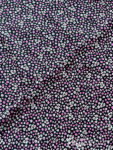
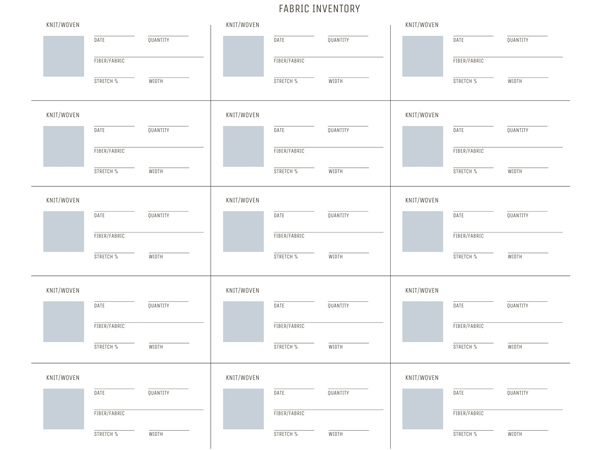
Great details! I have used this method before for a silk chiffon shirt and it worked really well and rinsed out easily but I didn’t write down the proportion of gelatin to water that I used. This is now in my ‘Sewing Hints’ file. Thanks Paulette 💕
Thanks for your detailed instructions. I have 8 yards of embroidered net fabric I need to cut into table runners. I want to cut the fabric in half lengthwise and into table length sections. The cuts don’t have to be exact, exact, but I would like them to look nice and neat. If I use the gelatin stiffening method, should I cut it into table length sections first, then soak it, dry it, and finally cut it lengthwise? Will the fabric be too stiff to crumple up artistically on the tables? If so, can the gelatin be washed out after… Read more »
Erin this is a great question. I don’t think there’s a wrong way to do it. What it comes down to is can you physically lay 8 yards of fabric out to dry without it falling off grain? Personally I could not so I would cut it up first and then do it in batches. Best of luck!
PS: yes, the gelatin washes out super easily. It’ll even melt as you press your stitches.
Thank you for this recipe! I have used gelatin before, but more in making it up as I go way.
I would like to use this on silk but am nervous to mess up my beautiful fabric! How did you wash it out? By hand? Did it take multiple washings?
Meaghan I have really good news for you: it washes out sooooo easily. It’ll even start to melt as you press your stitches. You may not even have any gelatin left on your garment once you’re done making it! And I’m not super precious with my handmade items, even when made with silk. I don’t have the patience or time for handwashing, so I simply wash them on delicate and then airdry them. Don’t be afraid of messing up your fabric!! Just make sure to measure twice 😉